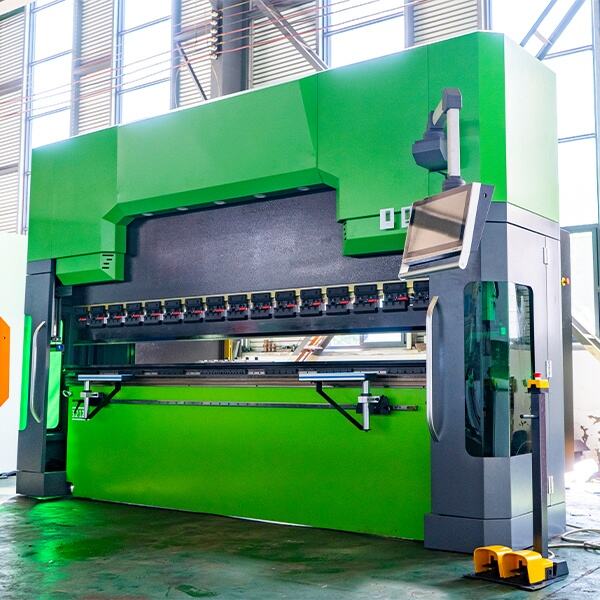Core Advantages of Offline Programming for CNC Press Brakes
Reducing Machine Downtime & Maximizing Throughput
Using offline programming with CNC press brakes helps cut down on machine downtime, which is really important for getting more done in production shops. When programmers work separately from actual machine operation, the press brake keeps making parts instead of sitting around waiting for setup changes. Some industry reports show that shops adopting this approach often see throughput improvements around 30 percent, sometimes even better. This makes a big difference especially when dealing with lots of different part designs or small production runs. The time saved translates directly into money saved too. Shops report being able to take on more jobs without buying additional equipment, and maintenance costs drop since machines aren't running constantly just to stay warm during setups.
Precision and Accuracy in Complex Bending Operations
For complex bending work where precision matters most, offline programming brings some serious advantages that just cant be ignored. With advanced simulation tools now available, fabricators get much better control over their bends, something absolutely essential when dealing with complicated parts. The latest software has pushed accuracy boundaries down to around 0.01 mm mark, which is pretty much required standard in sectors such as aerospace manufacturing and car production where tight tolerances are part of daily business. Better accuracy means less wasted material, consistent product quality across batches, and happier customers who know theyre getting what they paid for. And lets face it, happy customers keep coming back, which protects company reputation and keeps those bottom lines looking good.
Scalability for Small Batches and High-Mix Jobs
Manufacturing has changed so fast lately that being able to work with small batch sizes and handle all sorts of different products without major slowdowns is pretty much necessary now. Offline programming really shines when dealing with these kinds of production challenges, which makes it super important for factories running on just-in-time schedules. The way this technology scales means manufacturers can adjust their operations quickly as markets shift around them, keeping them competitive against bigger players. When companies streamline their workflow using offline programming tools, they get faster turnaround times while still staying flexible enough to accommodate whatever customers throw at them next.
Overcoming Resistance to Technological Adoption
Addressing Workforce Apprehensions and Skill Gaps
One big problem companies face when implementing offline programming systems is worker anxiety about job security. Factory floor technicians and maintenance staff worry that new tech might take away their jobs entirely. Addressing this fear requires honest conversations about where automation actually fits into operations. When management shows workers how their roles will change instead of disappear, people tend to feel better about adapting. For instance, teaching machinists to work alongside robots rather than being replaced by them builds trust over time. Companies that host monthly Q&A sessions, share case studies from similar industries, and let experienced workers train newcomers find smoother transitions overall. The key lies in making sure everyone understands they're not just cogs in a machine but essential parts of an evolving system.
Balancing CNC Press Brake Price with Long-Term ROI
People looking at bringing offline programming into their operations usually compare what they pay upfront for a CNC press brake versus how much money they might save down the road. Figuring out if it makes financial sense is really important when explaining why spending extra now could be worth it later. What matters most is being able to show actual numbers behind things like less time machines sitting idle, better workflow during production runs, and lower wages paid out because workers don't need to spend as many hours operating equipment manually. Take a look at real world situations where shops implement this technology. They find themselves needing far fewer people standing right next to machines all day long. That means getting more parts made in less time overall. When presented these facts about increased output and cost reductions, managers start seeing those early expenses not just as costs but rather investments that ultimately boost profits across the board.
Training Strategies for Seamless Transition
Training workers properly is key when moving to offline programming systems. A good approach combines classroom sessions, online courses, and buddy systems where seasoned technicians work alongside new hires. Workshops are particularly useful because they let people tackle actual problems while getting familiar with how things work in practice. When veterans take time to show新人 the ropes, it speeds up the learning curve and builds trust in handling unfamiliar tech. This kind of preparation pays off in the long run, making sure everyone knows their stuff and helping factories switch to better production methods without major disruptions.
Enhancing Workflow Efficiency with CNC Hydraulic Integration
Optimizing Tooling Libraries for CNC Hydraulic Press Brakes
Getting tooling libraries right for those CNC hydraulic press brakes really matters if companies want better efficiency and shorter setup times. When everything's organized properly in the tool storage area, workers don't waste precious minutes hunting around for what they need when production starts up. This kind of organization helps keep things moving smoothly throughout the day. Operators spend less time looking through drawers and boxes and more time actually making sure parts meet specifications. For shops trying to stay competitive, fixing up how tools are stored pays off big time. No one wants to stop production because some die is missing or misplaced somewhere in the chaos of the workshop floor.
Error Reduction Through Virtual Simulations
Virtual simulations used in the offline programming stage cut down on mistakes significantly, improving overall product quality. When manufacturers run these simulations, they spot problems early on before real production starts something that saves money and reduces wasted materials. Most factories find this makes sense because catching errors digitally instead of dealing with them later on the factory floor saves both time and resources. The manufacturing world has seen better results across the board when companies adopt this method. Products come out consistently good, and customers tend to be happier with what they receive since there are fewer defects and delays.
Integration with CAD and Laser Cutting Systems
When companies combine offline programming with their CAD software and fiber laser cutting machines, they get a much better way to manage production workflows. The system allows information to flow between different parts without so many problems that come from typing things manually or having separate systems talk to each other. Better data sharing means fewer mistakes and more consistent results across the board. What makes this setup really valuable is how everything connects properly on the factory floor. Machines don't just run independently anymore but actually communicate with each other, cutting down on confusion between departments and making sure the whole operation runs smoother day after day.
The Future of Offline Programming: AI and Industry 4.0
AI-Driven Predictive Analytics for Tooling Maintenance
Predictive analytics powered by artificial intelligence is changing how we approach tooling maintenance, giving manufacturers better ways to spot problems before they get out of hand. These systems keep an eye on what's happening inside machines and tell us when something needs attention instead of letting things break down first. Some research shows that companies using this kind of maintenance cut their downtime by around 20-25%, which makes a real difference in how productive factories can be. Beyond just saving money on those surprise repair bills, these analytics help plan production better so machines stay running smoothly most of the time. Many plant managers report seeing improvements within just a few months after implementing these smart monitoring systems.
Synergy with Fiber Laser Cutting Machine Workflows
When companies bring offline programming into their workflow for fiber laser cutting machines, they usually see smoother operations and better product quality across the board. The way programming works alongside the actual cutting process creates a kind of synergy that brings both precision and efficiency to the table while keeping things manufacturable from start to finish. Programmers can tweak designs right at the beginning stage before moving on to production, which cuts down on those frustrating redesigns and mistakes that often happen with manual input systems. For manufacturers dealing with tight deadlines, this integrated method keeps quality consistent run after run and shortens wait times significantly. Most shops report seeing noticeable improvements in their bottom line once they make the switch to this coordinated approach.
Autonomous CNC Press Brake Operations
Autonomous operations are starting to take shape in the world of CNC press brakes, marking what many see as a major advancement in shop floor efficiency while cutting down on reliance on human workers. These evolving systems could completely change how manufacturers approach their workflows, taking over repetitive tasks that used to need constant operator attention. Though still relatively new territory for most shops, some early adopters report saving around 40% on labor costs once everything gets properly set up across multiple machines. What makes these systems so attractive isn't just the money saved on wages though. When machines can plan their own work schedules and move seamlessly from one job to another without stopping, factories simply produce more parts per day. For companies looking ahead at long term production planning, investing in autonomous CNC tech looks increasingly smart despite the upfront costs involved.
Implementing Offline Programming: Key Steps for Success
Evaluating Press Brake Compatibility and Software Needs
Before jumping into offline programming, it makes sense to check if current CNC press brakes will work well with whatever software gets chosen. Compatibility matters because nobody wants software that doesn't play nice with their machines. Take some time looking at what kind of machining tasks need doing versus what features different programs actually offer. Getting this right from day one saves headaches later when setting everything up and running operations. Most shops find they get much better results when they spend proper time upfront figuring out exactly what they need instead of rushing through the process.
Phased Integration to Minimize Production Disruption
Going slow with the integration of offline programming helps keep things running smoothly during transition periods. When companies take it step by step, their production lines don't grind to a halt, something especially important for big operations where downtime costs money. Start small first, maybe just one section at a time, giving staff enough room to get comfortable with these new techniques before rolling them out everywhere. This kind of approach keeps everything moving forward while still leaving space to spot problems early on and figure out where extra training might be needed as things unfold.
Monitoring Performance Metrics for Continuous Improvement
For offline programming projects to work well, keeping an eye on how things perform after they're put into action makes all the difference. Look at stuff like how long cycles take, how many defects show up, and what the overall equipment effectiveness (OEE) numbers look like to see if everything's going according to plan. These numbers tell stories about where improvements might be needed. When operations keep checking these stats regularly and making small adjustments along the way, efficiencies tend to improve naturally over months rather than weeks. This kind of attention usually pays off in better productivity and gets more value out of the money spent on setting up those offline systems.



